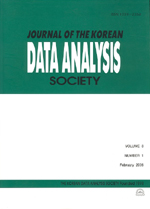주가지수수익률과 정보거래량이 비대칭적 내재변동성에 미치는 영향
The Impact of Index Return and Information Trading Volume on the Intraday Implied Volatility
- 한국자료분석학회
- Journal of The Korean Data Analysis Society (JKDAS)
- Vol.18 No.6
-
2016.123155 - 3172 (18 pages)
- 13

옵션 내재변동성지수는 주가 상승기 보다 주가 하락기에 더 큰 반응을 보여 소위 ‘공포지수’로 알려져 있다. 본 연구는 2010년 9월부터 2016년 6월 기간의 우리나라의 KOSPI200 현물 및 선물 가격과 거래량의 10분 단위 가격변동, 정보거래량 불균형비율이 KOSPI200 옵션 내재변동성지수(VKOSPI)의 변동과 그 비대칭성에 미치는 영향을 분석한다. 정보거래량 불균형비율의 영향은 Easley, López de Prado, O Hara(2013)가 제안한 모형을 바탕으로 검증하였고 내재변동성의 수익률에 대한 비대칭성에 관한 가설을 검증하기 위하여 Hibbert, Daigler, Dupoyet(2008)가 제안한 모형을 이용하였다. 본 연구의 주요 분석결과는 다음과 같다. 첫째, KOSPI200 수익률과 KOSPI200 선물지수수익률뿐만 아니라 거래량 불균형비율도 VKOSPI의 변동을 설명하는 요인으로 파악되었으며 선물시장 정보의 설명력이 현물시장의 설명력보다 더 높게 관측되었다. 둘째, VKOSPI의 고변동성기간에서의 수익률 및 거래량 불균형비율의 설명력이 저변동성기간의 설명력보다 훨씬 높은 것으로 나타났다. 셋째, 비대칭적 변동성은 초단기 기간에도 관측되어 비대칭성을 장기적인 현상으로 설명하던 레버리지가설과 변동성환류가설은 초단기간의 비대칭적 변동성 현상을 설명할 수 없는 것으로 확인되었으며, 초단기 비대칭적 변동성은 대표성, 감정 휴리스틱, 외삽편의와 같은 행동재무가설의 관점에서 해석이 가능하였다.
This study investigates impacts of KOSPI200 (nearby futures) return and information imbalanced volume ratio (IBR) on the intraday implied volatility (VKOSPI) in the Korean stock market using the 10 minutes data from September 2010 to June 2016. IBRs are computed based on the model suggested by Easley, López de Prado, O Hara (2013). In the part 1, the relationship between index returns (IBR) and changes in VKOSPI are examined and following results are found. Changes in VKOSPI and returns are negatively related. IBR has explanatory power on VKOSPI but returns are found to be more important variable than IBR. Also the KOSPI futures market has more explanatory power on VKOSPI than the cash market. In the part 2, competing hypotheses regarding asymmetric return-volatility relation are tested and following results are found. Asymmetric return-volatility relation was also found in the intraday behavior of VKOSPI. According to test results, leverage hypothesis and volatility feedback hypothesis can not adequately explain asymmetric return-volatility relation. Instead, behavior explanation such as representativeness, affect heuristic, extrapolation bias is found to be more persuasive hypothesis for the intraday asymmetric return-volatility relation in the Korea financial market.
1. 서론
2. 자료와 연구모형
3. 실증분석
4. 결론
References
(0)
(0)